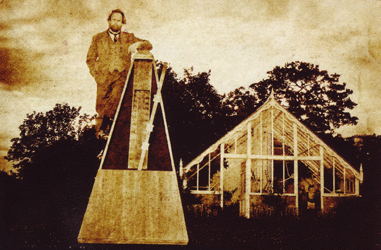The Time Machine (Tour – Cambridge)
There’s something about the infinite possibilities of time (not to mention space) travel which have attracted writers for millennia. HG Wells was among them.

© Shelagh Bidwell
The Time Machine was published in 1895 and kick-started Wells' literary career. The protagonist is never named; he's simply the Time Traveller, recounting his adventures once he had launched his machine – constructed on the most up-to-date scientific principles of the late 19th century – from his riverside Richmond garden.
Robert Lloyd Parry is both the adapter and performer, also (presumably) his own director. The stage is furnished with a garden chair and a birdbath but is dominated by the machine itself. Lloyd Parry tumbles out of this somewhat Heath Robinson contraption to recount his journey to the year 802701.
When the machine lands, he finds that a miniature race of fruit-eating playful mannikins, the Eloi, inhabit the surface of the world. He rescues one of them from the nearby river; it's a girl called Weena. They don't have a language in common and the Eloi find him as strange as he does them. But the surface gaiety of their life has an ever-present underground threat.
This comes from the Morlocks, as nasty a set of globular white-faced, long-fingered creatures as you're likely to encounter outside Grimm or the Nilbelungenlied. Slowly he realises that mankind has not simply developed with greater refinement, increased wisdom and enhanced charity – it has fractured. Nastily.
The story is put over with clarity and some fleeting humorous references which take account that we're hearing this some 120 years after the novella was first written. "Ancient history yet to come", as the Time Traveller says at one point. Lloyd Parry carries conviction with his portrait of a man whose faith in his own rationality, indeed superiority, is tested literally by fire.
The Time Machine is on national tour until 31 July.












